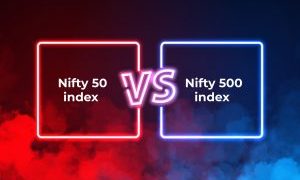We all know, Mutual funds and ETFs are the ultimate investment duo. But, we often get confused about where to park our money between the two. While both choices have their individual benefits, there is no single model for the right investment avenue. And it is important to understand the nitty-gritty of both investment avenues to nominate the right one for your needs.
Investing in mutual funds and exchange-traded funds (ETFs) is a popular way for retail investors to participate in the stock market without having to pick individual stocks. Both mutual funds and ETFs offer investors the opportunity to diversify their portfolios across a wide variety of asset classes, sectors, and geographies. However, there are some key differences between these two investment vehicles that you should be aware of before deciding which one is right for you.
In this blog post, we’ll explore the differences between mutual funds and ETFs and help you choose which one is right for you as per your needs. But before that, let’s get our definitions clear about what mutual funds and ETFs are.
What are mutual funds?
A mutual fund is a pool of money collected from investors to purchase a portfolio of stocks, bonds and other assets. It helps investors diversify their investment with lesser risk compared to individual stock picking. This mutual fund is managed by a professional fund manager who is responsible for buying and selling assets to achieve the fund’s investment objective. Mutual funds are priced at the end of each trading day based on the net asset value (NAV) of the fund’s holdings. Here are some ways mutual funds can benefit you:
Advantages of mutual funds:
1. Professional Management
One of the basic advantages of mutual funds is that they are managed by professional investment managers with the technical expertise to make investment decisions on behalf of the investors. These managers have access to extensive research and analytical tools that individual investors may not have, which can lead to better investment decisions.
2. Diversification
Another advantage of mutual funds is that they offer investors the ability to diversify their portfolios across a variety of asset classes, sectors, and geographies. Usually, mutual funds invest in assets that share a low correlation with each other, meaning if one asset underperforms, the other gives good returns. This can help mitigate the risk of losses due to the performance of any one individual stock or sector.
3. Liquidity
Mutual funds can be bought and sold at the end of each trading day at the current NAV price, making them highly liquid investment vehicles. Hence, they are easily redeemable at the time of immediate liquidity requirement.
What are ETFs?
An exchange-traded fund (ETF) is a type of investment vehicle that tracks the performance of a specific index or benchmark. ETFs are traded on an exchange like a stock and can be bought and sold throughout the trading day. ETFs are priced based on the current market price of the fund’s holdings.
Advantages of ETFs
1. Low fees
ETFs generally have lower fees compared to mutual funds, which can help investors keep more of their investment returns over time.
2. Transparency
ETFs are required to disclose their holdings on a daily basis, which can provide investors with greater transparency into what they are investing in.
3. Flexibility
ETFs can be bought and sold throughout the trading day, which provides investors with greater flexibility to enter and exit their positions as needed.
Difference between Mutual Funds and ETFs
1. Investment structure
Mutual funds and ETFs have different investment structures. Mutual funds are open-end funds, which means they issue new shares to investors as they enter the fund and redeem shares as they exit the fund. Mutual funds are bought and sold through the fund company at the end of each trading day at the NAV of the underlying assets in the fund.
ETFs, on the other hand, are exchange-traded products that are bought and sold on an exchange like a stock. ETF shares can be traded during market hours at their market price, which is determined by their supply and demand. ETFs are structured as a creation and redemption process. This means that new shares of an ETF are created when there is demand for the fund and redeemed when there is a need to reduce supply.
2. Trading
The trading process for mutual funds and ETFs is different. Mutual funds are priced at the end of each trading day based on the NAV of the underlying assets in the fund. Investors can buy or sell mutual fund shares directly from the fund company. ETFs, on the other hand, are traded during the day like stocks, and their prices can fluctuate based on supply and demand in the market. ETF investors can buy or sell shares on an exchange through a brokerage account.
3. Fees
Mutual funds typically have higher fees than ETFs. This is because mutual funds are actively managed, which means that the fund manager is actively buying and selling securities to try to outperform the market. This active management requires more administrative overhead and research expenses, which are passed on to the investor in the form of higher fees. ETFs, on the other hand, are typically passively managed and aim to track a specific index, so they require less overhead and research expenses, resulting in lower fees.
4. Tax implications
Mutual funds and ETFs have different tax implications. Mutual funds are subject to capital gains taxes when the fund sells assets at a profit, and these taxes are passed on to the individual shareholders. This means that investors may owe taxes on gains they did not realize themselves. ETFs, on the other hand, may be more tax-efficient than mutual funds because they are structured differently and can avoid capital gains taxes by using a process called in-kind redemptions. In-kind redemptions allow ETFs to swap securities with authorized participants without triggering capital gains taxes. This means that ETF investors may owe less in taxes than mutual fund investors.
5. Minimum investment requirements
Mutual funds often have higher minimum investment requirements than ETFs. Some mutual funds require minimum investments of thousands of dollars, which can make them less accessible to smaller investors. ETFs, on the other hand, can be purchased in single shares, which makes them more accessible to a broader range of investors.
Mutual Funds or ETF – Which is right for you
Deciding which investment vehicle is right for you depends on your individual investment goals, risk tolerance, and investment style. Here are some factors to consider:
1. Investment goals
If your investment goal is to achieve long-term growth, mutual funds may be a better choice because they are actively managed by investment professionals who can make investment decisions to maximise returns. If you are looking for lower fees and want to track a specific index or benchmark, ETFs may be a better choice.
2. Risk tolerance
If you are a conservative investor who is looking for a diversified portfolio with less risk, mutual funds may be a better choice because they offer professional management and diversification across a variety of asset classes. If you are willing to take on more risk and are comfortable with more volatile investments, ETFs may be a better choice because they allow for greater flexibility and can offer exposure to specific sectors or geographies.
3. Investment style
If you prefer a passive investment approach, ETFs may be a better choice because they track specific indices or benchmarks and do not require active management. If you prefer a more active investment approach and want a professional to make investment decisions on your behalf, mutual funds may be a better choice.
Bottom Line
Investing in mutual funds or ETFs can be a great way to diversify your portfolio and participate in the stock market. Both investment vehicles have their advantages and disadvantages, and the choice between mutual funds and ETFs ultimately depends on your individual investment goals, risk tolerance, and investment style. By understanding the differences between these two investment vehicles, you can make an informed decision and choose the investment vehicle that is right for you.
Disclaimer: This blog has been issued on the basis of internal data, publicly available information and other sources believed to be reliable. The information contained in this document is for general purposes only and not a complete disclosure of every material fact. The information/data herein alone is not sufficient and shouldn’t be used for the development or implementation of an investment strategy. It should not be construed as investment advice to any party. All opinions, figures, estimates and data included in this blog are as on date. The blog does not warrant the completeness or accuracy of the information and disclaims all liabilities, losses and damages arising out of the use of this information. The statements contained herein may include statements of future expectations and other forward-looking statements that are based on our current views and assumptions and involve known and unknown risks and uncertainties that could cause actual results, performance or events to differ materially from those expressed or implied in such statements. Readers shall be fully responsible/liable for any decision taken on the basis of this article.
Mutual Fund investments are subject to market risks, read all scheme related documents carefully.








































